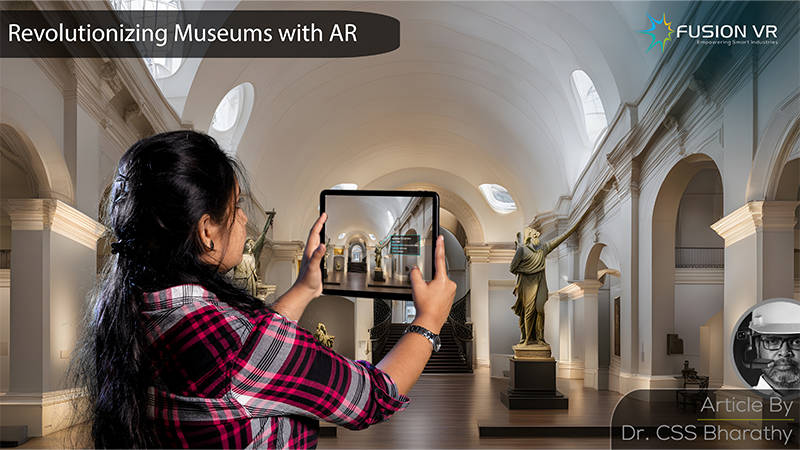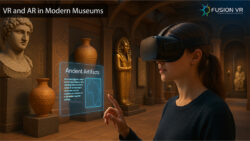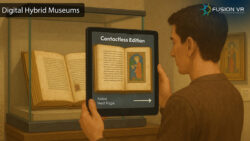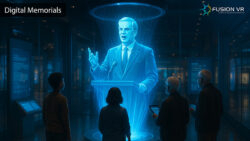Augmented reality (AR) is one of the most interesting technologies that will deliver on the promise of transforming today’s traditional museums into exciting interactive spaces that will appeal to visitors of all ages and backgrounds. AR technology achieves this by seamlessly integrating the physical and digital aspects of a museum. Armed with AR, museum curators can bring about a resurgence in the public’s interest in art, history, and culture. I have been associated with improving the museum experience for more than a decade and I’m going to share some examples of how AR can transform museums that make it more appealing to the average visitor. These range from designing interactive exhibits to virtual time travel to an earlier era. It is an adventure that is truly worth embarking on.
Augmented reality is an exciting digital technology that helps to superimpose or overlay images, animation, voice, text etc. on top of what a person sees around themselves. This technology is available on a smartphone, tablet or AR wearables such as AR goggles. AR does not take a person away from their surrounding reality but enhances their experience with additional information and experiences. All the user needs to do is open up an AR Application and hold it in front of a museum exhibit or artifact and his or her experience will roll out. The app engages the visitor to provide the best experience a museum visitor expects. This blog is to take you on an amazing adventure to understand the breadth and range of experiences this technology provides.
AR makes interactive exhibits possible and brings the quiet static exhibits jumping back to life. The ubiquitous smartphone is one of the AR-enabled devices which can quickly scan an artwork or artifact and present additional details and layers of interesting information about it. This experience is designed to be interactive and engaging. The visitor at an art museum could open an AR App on their smartphone, direct it to a Ravi Varma painting, and the app would reveal biographical information about the artist, how the painting was created and many more interesting details. This information can be presented as text, audio or a combination of all that in animation. You could also bring an art expert on the screen to present more information that is quite personable. This kind of engagement enriches the visitor’s understanding of the exhibits in the museum. The AR museum experience leaves them remembering about the artifact long after they’ve seen it.
Let’s look at Virtual Time Travel now. In this experience, the AR app would transport a visitor back in time and allow them an experience that people then had. You could witness a historical event that you wish you had been a part of using AR glasses, like witnessing the speech of a famous leader or an event that was a turning point in history. These experiences come alive in front of your eyes and enable you to relive a slice of history. Taking this a step further is to reconstruct ancient structures and cities. What did Mamallapuram and its complete seven shore temples look like? Many believe they have been submerged by the sea except for one. The reconstruction of such historical scenarios reproduces the grandeur and glory of those days and helps the young generation to take pride in their history and culture.
Augmented reality will also enable the transformation of 2D artworks into exciting 3D exhibits. This can be experienced with AR glasses that allow a visitor to explore and appreciate the artwork in greater detail. A sculpture and its finer features from all sides and angles can be viewed using this 3D exploration feature. The proximity that this feature allows is particularly important for art students, teachers and researchers.
We all know that museums are all about exploration. Just imagine if that experience is gamified. Yes, this is something that makes it thrilling for people of all ages, particularly children. They love a challenge and are always open to anything that is exciting. Museum apps can make the learning journey interesting with scavenger hunts where a visitor needs to find clues and identify important artifacts and get rewarded when they accomplish the challenge. These rewards can be used in the museum and shared with other entities.
Augmented reality experiences in museums enable kids to get up close and personal with nature and enjoy its beauty and grandeur. Museums have created AR experience centers that usher children into a space that feels like a rainforest and by scanning the surroundings with a smartphone or tablet, the child sees animals and birds that are natural residents of that ecosystem. The experience can be animated and gamified to maximize the interactive experience. This engagement is unforgettable for most visitors and the learning experience for the kids is almost permanent. They also obtain a deeper understanding and appreciation of nature and the importance of sustainability in today’s world.
AR is a great technology that flattens the technological and economic landscape in the world. It helps in removing language barriers that one may encounter in a museum that uses a language the speaker is unfamiliar with. AR apps can be designed to cater to various languages and exhibit the information in the visitor’s language. This is very useful in a country like India where multiple languages exist and enables visitors from all states and in fact from all over the world to enjoy the museum. AR enables greater access and inclusiveness for a global visitor experience.
With AR, museum visitors can choose the length and depth of their experience. Visitors who are experts can enjoy an in-depth analysis, while novices can go for simpler explanations. This helps visitors to choose their level of experience in interactive museums. The AR app also enables connectivity with social media, allowing visitors to share their experiences with their friends and communities. Selfies can be taken with exhibits and artifacts, reward certificates, badges etc can be shared quickly and remain part of their social media history.
The fun and most promising aspect of augmented reality is that we can access it using affordable devices, like the smartphone. This device has become a necessity and is enabling access to experiences not previously available to many communities across the globe. This technology is empowering many societies to take charge of their own learning and experiences. This empowerment is instrumental in the transformation of societies and helping them achieve a brighter future.
Fusion VR is a leader in the efforts to integrate augmented reality, and virtual reality into existing and new museums in India. The Amma Museum and Knowledge Park in Chennai is a good example of how AR has been used. This museum showcases the life and times of the late Chief Minister of Tamil Nadu, Dr. J. Jayalalithaa. We received tremendous appreciation from the press and public and it stands as a testament to the Museum 2.0 skill set that Fusion VR provides. I encourage you to check our Museums and Corporate Experience Centres webpage to learn more about our projects and the contributions we have made towards the journey to Museum 2.0.
In conclusion, augmented reality has unlimited potential to transform and redefine the traditional museum experience. The use of AR and other technologies in museums is a highly transformative undertaking. By transforming today’s museums into AR experience centers, we are making it more engaging and accessible to diverse audiences. One is for sure, that AR will ensure the continued relevance and appeal of museums in an ever-changing world.





